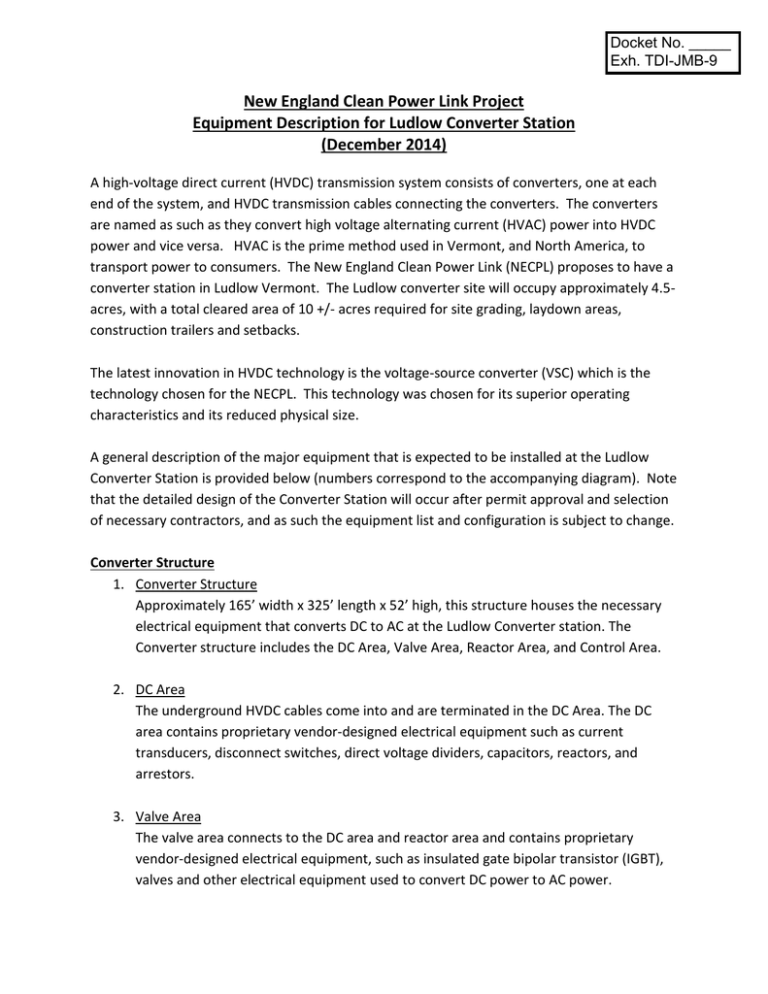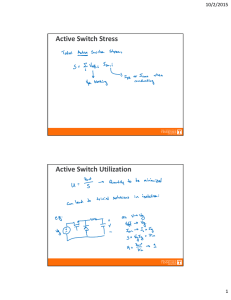(Converter Station - Equipment Description).
advertisement

Docket No. _____ Exh. TDI-JMB-9 New England Clean Power Link Project Equipment Description for Ludlow Converter Station (December 2014) A high-voltage direct current (HVDC) transmission system consists of converters, one at each end of the system, and HVDC transmission cables connecting the converters. The converters are named as such as they convert high voltage alternating current (HVAC) power into HVDC power and vice versa. HVAC is the prime method used in Vermont, and North America, to transport power to consumers. The New England Clean Power Link (NECPL) proposes to have a converter station in Ludlow Vermont. The Ludlow converter site will occupy approximately 4.5acres, with a total cleared area of 10 +/- acres required for site grading, laydown areas, construction trailers and setbacks. The latest innovation in HVDC technology is the voltage-source converter (VSC) which is the technology chosen for the NECPL. This technology was chosen for its superior operating characteristics and its reduced physical size. A general description of the major equipment that is expected to be installed at the Ludlow Converter Station is provided below (numbers correspond to the accompanying diagram). Note that the detailed design of the Converter Station will occur after permit approval and selection of necessary contractors, and as such the equipment list and configuration is subject to change. Converter Structure 1. Converter Structure Approximately 165’ width x 325’ length x 52’ high, this structure houses the necessary electrical equipment that converts DC to AC at the Ludlow Converter station. The Converter structure includes the DC Area, Valve Area, Reactor Area, and Control Area. 2. DC Area The underground HVDC cables come into and are terminated in the DC Area. The DC area contains proprietary vendor-designed electrical equipment such as current transducers, disconnect switches, direct voltage dividers, capacitors, reactors, and arrestors. 3. Valve Area The valve area connects to the DC area and reactor area and contains proprietary vendor-designed electrical equipment, such as insulated gate bipolar transistor (IGBT), valves and other electrical equipment used to convert DC power to AC power. 4. Reactor Area The Reactor Area connects to the Valve Area and the AC Yard and contains proprietary vendor-designed electrical equipment such as reactors, arrestors, and current transformers. 5. Control Area Electrical control and protection equipment, (cabinets, computers, etc.) are housed in the Control Area. All operations of the HVDC converter station are typically managed remotely so the station will be unmanned. In addition to the equipment areas within the Converter Structure, the Converter Station site will contain the following equipment located in outdoor areas: AC Yard 6. Wall Bushings Overhead AC cables exit the Reactor Area through wall bushings into the AC Yard. 7. Capacitance-Coupled Voltage Transformer (CCVT) CCTV is a transformer used in power systems to step down extra high voltage signals and provide a low voltage signal, for control, metering or operating a protective relay. 8. Air-Core Series Reactor This reactor is series-connected to the transmission line or to the feeder to reduce/eliminate harmonic currents. 9. Transformer Area The transformer area is located within the AC Yard and contains three single phase power transformers and one spare transformer. Single phase rating of each transformer is 350MVA 345kV/420kV. 10. Pre-Insertion Resistor This resistor limit inrush currents that can occur during energization of the converter station and the DC cable circuit. 11. Disconnect Switch Disconnect switches are used to isolate a circuit after the current has been interrupted by other means. It is used to ensure that an electrical circuit is completely de-energized for service or maintenance. 2 12. Circuit Breaker The 345 kV AC breakers are used to energize the HVDC transmission system and to disconnect/trip the HVDC station. The breaker will be rated for the maximum fault current duty at the interconnection point (i.e., the existing Coolidge Substation). 13. Lightning Protection Masts Lightning protection for the outside AC Yard area. Other Equipment 14. Valve Coolers -- A cooling system is designed to dissipate the power losses generated in the converter valves through a closed loop pressurized nitrogen system. It consists of heat sinks in the converter valves, pumps, vessels, filters, measuring devices, outdoor coolers and interconnecting piping. The cooling liquid is deionized water, or a mixture of water and glycol, circulated by means of pumps. The cooling liquid is heated in the converter by the valve losses, and circulated to the coolers, where the heat is transferred to the ambient air. 15. Diesel Generator Enclosure -- The stand-by Diesel Generator system (DG) will be used to supply power to essential loads in case the primary auxiliary supply is unavailable. The diesel generator will be provided with a fuel tank capable of providing eight (8) hours of essential power required to maintain the Converter Station’s system on standby for a Black Start condition. 16. Auxiliary Transformer Area – The Auxiliary Transformer transforms auxiliary power supplied at medium voltage (e.g., 34.5 kV) to AC supply (600/345 V, 60 Hz) for the station’s own auxiliary systems. The auxiliary power will be provided from two independent supplies. The primary supply is from delta connected tertiary windings on the main power transformer units. The back-up AC auxiliary power supply (34.5 kV) is provided from a nearby AC substation. A standby diesel generator set will be provided as a backup for supplying all essential loads. 17. Spare Parts Building – located outside the Converter Building to house necessary spare parts. 3



